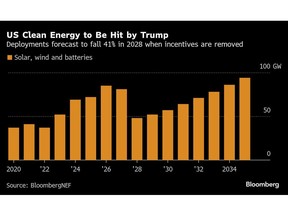
Article content
(Bloomberg) — US annual clean-energy installations will plunge 41% after 2027, due to the rapid phase-out of wind and solar tax credits in President Donald Trump’s sweeping economic legislation.
THIS CONTENT IS RESERVED FOR SUBSCRIBERS ONLY
Subscribe now to read the latest news in your city and across Canada.
- Exclusive articles from Barbara Shecter, Joe O'Connor, Gabriel Friedman, and others.
- Daily content from Financial Times, the world's leading global business publication.
- Unlimited online access to read articles from Financial Post, National Post and 15 news sites across Canada with one account.
- National Post ePaper, an electronic replica of the print edition to view on any device, share and comment on.
- Daily puzzles, including the New York Times Crossword.
SUBSCRIBE TO UNLOCK MORE ARTICLES
Subscribe now to read the latest news in your city and across Canada.
- Exclusive articles from Barbara Shecter, Joe O'Connor, Gabriel Friedman and others.
- Daily content from Financial Times, the world's leading global business publication.
- Unlimited online access to read articles from Financial Post, National Post and 15 news sites across Canada with one account.
- National Post ePaper, an electronic replica of the print edition to view on any device, share and comment on.
- Daily puzzles, including the New York Times Crossword.
REGISTER / SIGN IN TO UNLOCK MORE ARTICLES
Create an account or sign in to continue with your reading experience.
- Access articles from across Canada with one account.
- Share your thoughts and join the conversation in the comments.
- Enjoy additional articles per month.
- Get email updates from your favourite authors.
THIS ARTICLE IS FREE TO READ REGISTER TO UNLOCK.
Create an account or sign in to continue with your reading experience.
- Access articles from across Canada with one account
- Share your thoughts and join the conversation in the comments
- Enjoy additional articles per month
- Get email updates from your favourite authors
Sign In or Create an Account
or
Article content
Deployments will fall to 48 gigawatts in 2028 when wind and solar projects will lose eligibility for the tax incentives, according to a report Thursday from BloombergNEF. That’s compared to 81 gigawatts the prior year as developers race to complete projects before the cutoff date.
Article content
Article content
Article content
“A short path still exists for wind and solar projects to access these credits, but it will not be an easy road ahead for most developers,” analysts with BloombergNEF wrote in the report.
Article content
By signing up you consent to receive the above newsletter from Postmedia Network Inc.
Article content
While renewables are often the cheapest source of electricity, the forecast underscores the reliance clean energy still has on subsidies. Eliminating federal incentives threatens to upend the US energy industry by hampering the roll out of wind and solar, which have become the biggest sources of new electricity generation.
Article content
The decline will come at a critical moment, as the power industry scrambles to deliver additional capacity to meet an expected jump in demand from data centers running artificial intelligence.
Article content
New wind, solar and energy storage additions through 2030 will drop 23% compared to an earlier BNEF forecast as a result of the new legislation. Onshore wind will see a 50% cut compared to the prior outlook with solar and energy storage experiencing a 23% and 7% drop, respectively.
Article content
The shift will be especially hard on the solar industry. Once developers lose tax credits, only 30% of planned solar projects will be able to deliver competitive prices and are “expected to survive,” according to the research company Enverus. About 57% of wind farms will be competitive without credits, according to an Enverus report issued this week.
Article content
(Updates with comment from analysts in third paragraph)
Article content

.jpg) 5 hours ago
1
5 hours ago
1
 English (US)
English (US)